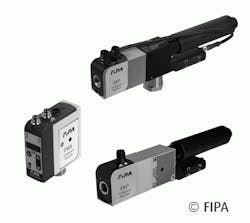EKPP, EKP, and EMM series ejectors conserve energy without compromising cycle times. Featuring automatic pressure regulation, they reduce compressed air usage by up to 50% per work piece, regardless of its porosity. EMA and EKP-LSE series achieve savings of up to 97% for airtight work pieces. Ejectors use 50.8 psi internally, reaching maximum vacuum at a feed pressure of 58 psi. Higher feed pressure is automatically reduced to 58 psi internally, meaning they never use more than 50.8 psi.
FIPA Inc., (919) 651-9888, bit.ly/hp113fipa


